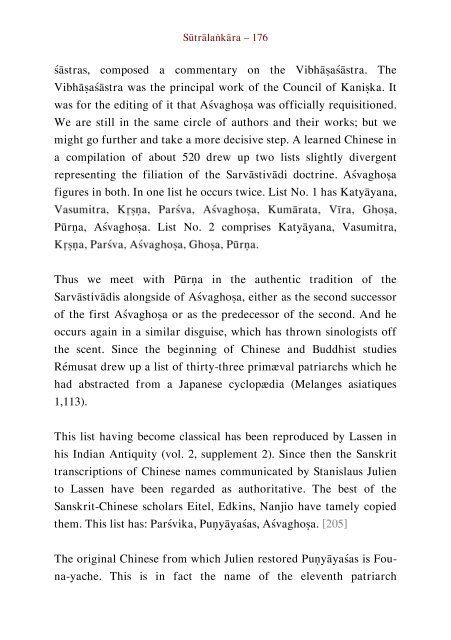Literary History of Sanskrit Buddhism
A study by J. K. Nariman of Sanskrit Buddhism from the Early Buddhist Tradition up to the Mahayana texts proper.
A study by J. K. Nariman of Sanskrit Buddhism from the Early Buddhist Tradition up to the Mahayana texts proper.
You also want an ePaper? Increase the reach of your titles
YUMPU automatically turns print PDFs into web optimized ePapers that Google loves.
Sūtrālaṅkāra – 176<br />
śāstras, composed a commentary on the Vibhāṣaśāstra. The<br />
Vibhāṣaśāstra was the principal work <strong>of</strong> the Council <strong>of</strong> Kaniṣka. It<br />
was for the editing <strong>of</strong> it that Aśvaghoṣa was <strong>of</strong>ficially requisitioned.<br />
We are still in the same circle <strong>of</strong> authors and their works; but we<br />
might go further and take a more decisive step. A learned Chinese in<br />
a compilation <strong>of</strong> about 520 drew up two lists slightly divergent<br />
representing the filiation <strong>of</strong> the Sarvāstivādi doctrine. Aśvaghoṣa<br />
figures in both. In one list he occurs twice. List No. 1 has Katyāyana,<br />
Pūrṇa, Aśvaghoṣa. List No. 2 comprises Katyāyana, Vasumitra,<br />
Thus we meet with Pūrṇa in the authentic tradition <strong>of</strong> the<br />
Sarvāstivādis alongside <strong>of</strong> Aśvaghoṣa, either as the second successor<br />
<strong>of</strong> the first Aśvaghoṣa or as the predecessor <strong>of</strong> the second. And he<br />
occurs again in a similar disguise, which has thrown sinologists <strong>of</strong>f<br />
the scent. Since the beginning <strong>of</strong> Chinese and Buddhist studies<br />
Rémusat drew up a list <strong>of</strong> thirty-three primæval patriarchs which he<br />
had abstracted from a Japanese cyclopædia (Melanges asiatiques<br />
1,113).<br />
This list having become classical has been reproduced by Lassen in<br />
his Indian Antiquity (vol. 2, supplement 2). Since then the <strong>Sanskrit</strong><br />
transcriptions <strong>of</strong> Chinese names communicated by Stanislaus Julien<br />
to Lassen have been regarded as authoritative. The best <strong>of</strong> the<br />
<strong>Sanskrit</strong>-Chinese scholars Eitel, Edkins, Nanjio have tamely copied<br />
them. This list has: Parśvika, Puṇyāyaśas, Aśvaghoṣa. [205]<br />
The original Chinese from which Julien restored Puṇyāyaśas is Founa-yache.<br />
This is in fact the name <strong>of</strong> the eleventh patriarch


















